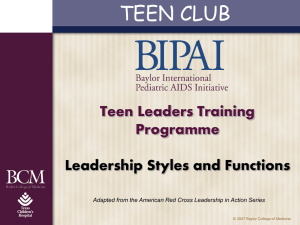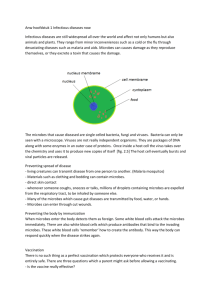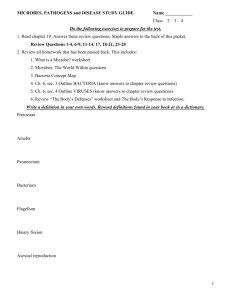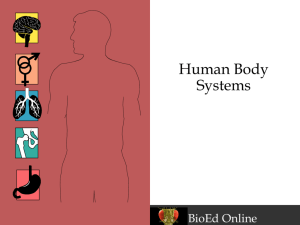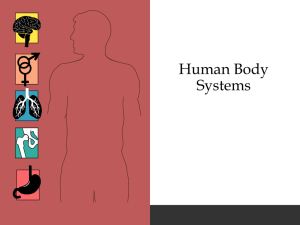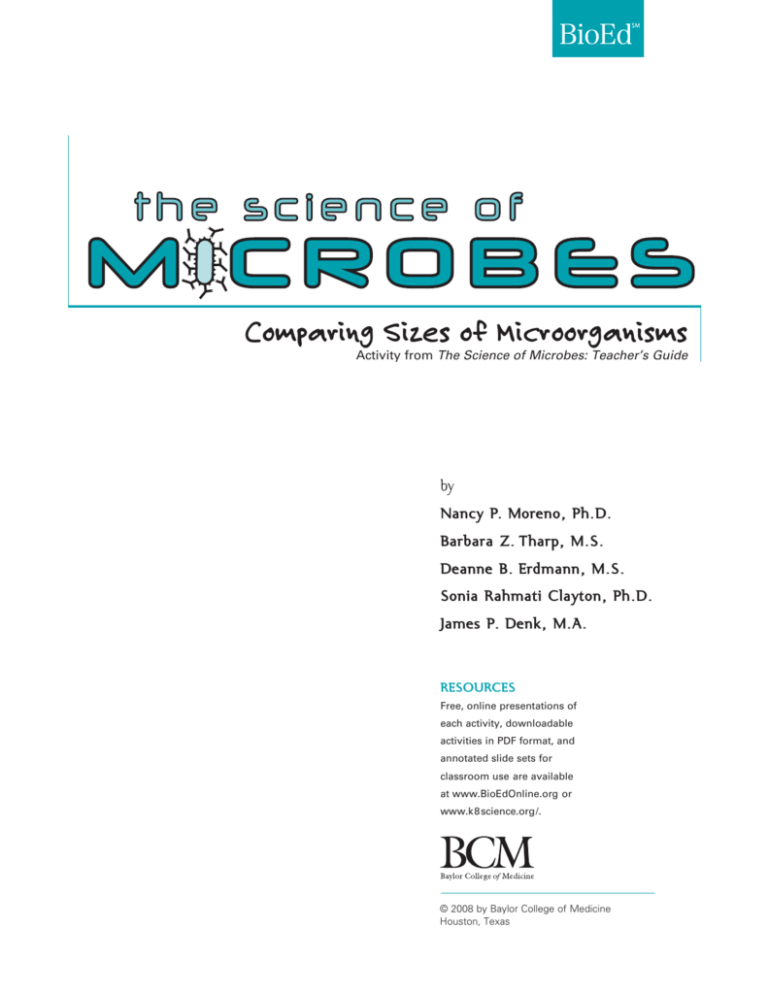
Comparing Sizes of Microorganisms
Activity from The Science of Microbes: Teacher’s Guide
by
Nancy P. Moreno, Ph.D.
Barbara Z. Tharp, M.S.
Deanne B. Erdmann, M.S.
Sonia Rahmati Clayton, Ph.D.
James P. Denk, M.A.
RESOURCES
Free, online presentations of
each activity, downloadable
activities in PDF format, and
annotated slide sets for
classroom use are available
at www.BioEdOnline.org or
www.k 8 science.org/.
© 2008 by Baylor College of Medicine
Houston, Texas
© 2008 by Baylor College of Medicine
All rights reserved.
Printed in the United States of America
ISBN-13: 978-1-888997-54-5
ISBN-10: 1-888997-54-0
Teacher Resources from the Center for Educational Outreach
at Baylor College of Medicine
The mark “BioEd” is a service mark of Baylor College of Medicine. The information contained in this publication is for educational
purposes only and should in no way be taken to be the provision or practice of medical, nursing or professional healthcare advice
or services. The information should not be considered complete and should not be used in place of a visit, call, consultation or
advice of a physician or other health care provider. Call or see a physician or other health care provider promptly for any health
care-related questions.
Development of The Science of Microbes educational materials is supported, in part, by a Science Education Partnership Award
from the National Center for Research Resources (NCRR) of the National Institutes of Health (NIH), grant number 5R25 RR018605.
The activities described in this book are intended for school-age children under direct supervision of adults. The authors, Baylor
College of Medicine (BCM), the NCRR and NIH cannot be responsible for any accidents or injuries that may result from conduct of
the activities, from not specifically following directions, or from ignoring cautions contained in the text. The opinions, findings and
conclusions expressed in this publication are solely those of the authors and do not necessarily reflect the views of BCM, image
contributors or the sponsoring agencies.
SOURCE URLs
Baylor College of Medicine
BioEd Online Teacher Resources
www.BioEdOnline.org | www.k 8 science.org
p. 3, 6, 10, 14, 26
Molecular Virology and Microbiology
www.bcm.edu /molvir
p. ii
Brookhaven National Laboratory
Biology - STEM Facility
www.biology.bnl.gov
p. 30
Centers for Disease Control
and Prevention
Public Health Image Library
www.cdc.gov
http:// phil.cdc.gov
Cover, pp. 1, 4, 5, 7, 8, 9, 10, 12, 13, 14, 17, 18, 20, 21,
22, 23, 24, 27, 28, 29, 31, 32, 33, 34, 35, 36, 39, 40, 41,
42, 45, 46, 48, 49, 50, 51, 52, 53, 54, 55, 56, 57, 58
Cover images of children and teacher (models) © 2007 PunchStock. Photographs used throughout this guide, whether copyrighted
or in the public domain, require contacting original sources to obtain permission to use images outside of this publication. The
authors, contributors, and editorial staff have made every effort to contact copyright holders to obtain permission to reproduce
copyrighted images. However, if any permissions have been inadvertently overlooked, BCM will be pleased to make all necessary
and reasonable arrangements.
Dartmouth College
Electron Microscope Facility
www.dartmouth.edu /~emlab/
pp. ii, 28, 35, 54
Many microscopic images used in this guide, particularly images obtained from the Public Health Image Library of the Centers for
Disease Control and Prevention (CDC), are part of an online library containing other images and subject matter that may be unsuitable for children. Caution should be used when directing students to research health topics and images on the Internet. URLs from
image source websites are provided in the Source URL list, to the right.
Drexel University
Materials Science and Engineering
www.materials.drexel.edu /breger
p. 28
Authors: Nancy P. Moreno, Ph.D., Barbara Z. Tharp, M.S., Deanne B. Erdmann, M.S.,
Sonia Rahmati Clayton, Ph.D., and James P. Denk, M.A.
Microimaging Services (Canada)
www.microimaging.ca
pp. 9, 14, 20
Creative Director and Editor: Martha S. Young, B.F.A.
Senior Editor: James P. Denk, M.A.
ACKNOWLEDGMENTS
This guide was developed in partnership with the Baylor-UT Houston Center for AIDS Research, an NIH-funded program (AI036211).
The authors gratefully acknowledge the support and guidance of Janet Butel, Ph.D., and Betty Slagle, Ph.D., Baylor-UT Houston
Center for AIDS Research; and William A. Thomson, Ph.D., BCM Center for Educational Outreach. The authors also sincerely
thank Marsha Matyas, Ph.D., and the American Physiological Society for their collaboration in the development and review of this
guide; and L. Tony Beck, Ph.D., of NCRR, NIH, for his assistance and support. In addition, we express our appreciation to Amanda
Hodgson, B.S., Victor Keasler, Ph.D., and Tadzia GrandPré, Ph.D., who provided content or editorial reviews; and J. Kyle Roberts,
Ph.D., and Alana D. Newell, B.A., who guided field test activities and conducted data analyses. We also are grateful to the
Houston-area teachers and students who piloted the activities in this guide.
We are endebted to many scientists and microscopists who contributed SEM and TEM images to the CDC’s Public Health Image
Library, including Janice H. Carr, James D. Gathany, Cynthia S. Goldsmith, M.S., and Elizabeth H. White, M.S. We especially
thank Louisa Howard and Charles P. Daghlian, Ph.D., Electron Microscope Facility, Dartmouth College, for providing several of the
SEM and TEM images used in this publication. We thank Martha N. Simon, Ph.D., Joseph S. Wall, Ph.D., and James F. Hainfeld,
Ph.D., Department of Biology-STEM Facility, Brookhaven National Laboratory; Libero Ajello, Ph.D., Frank Collins, Ph.D., Richard
Facklam, Ph.D., Paul M. Feorino, Ph.D., Barry S. Fields, Ph.D., Patricia I. Fields, Ph.D., Collette C. Fitzgerald, Ph.D., Peggy S. Hayes.
B.S., William R. McManus, M.S., Mae Melvin, Ph.D., Frederick A. Murphy, D.V.M., Ph.D., E.L. Palmer, Ph.D., Laura J. Rose, M.S.,
Robert L. Simmons, Joseph Strycharz, Ph.D., Sylvia Whitfield, M.P.H., and Kyong Sup Yoon, Ph.D., CDC; Dee Breger, B.S., Materials
Science and Engineering, Drexel University; John Walsh, Micrographia, Australia; Ron Neumeyer, MicroImaging Services, Canada;
Clifton E. Barry, III, Ph.D., and Elizabeth R. Fischer, National Institute of Allergy and Infectious Diseases, NIH; Mario E. Cerritelli,
Ph.D., and Alasdair C. Steven, Ph.D., National Institute of Arthritis and Musculoskeletal and Skin Diseases, NIH; Larry Stauffer,
Oregon State Public Health Laboratory-CDC; David R. Caprette, Ph.D., Department of Biochemistry and Cell Biology, Rice University;
Alan E. Wheals, Ph.D., Department of Biology and Biochemistry, University of Bath, United Kingdom; Robert H. Mohlenbrock, Ph.D.,
USDA Natural Resources Conservation Service; and Chuanlun Zhang, Ph.D., Savannah River Ecology Laboratory, University of
Georgia, for the use of their images and/or technical assistance.
No part of this book may be reproduced by any mechanical, photographic or electronic process, or in the form of an audio recording;
nor may it be stored in a retrieval system, transmitted, or otherwise copied for public or private use without prior written permission of the publisher. Black-line masters reproduced for classroom use are excepted.
Center for Educational Outreach, Baylor College of Medicine
One Baylor Plaza, BCM411, Houston, Texas 77030 | 713 -798 - 8200 | 800 -798 - 8244 | edoutreach@bcm.edu
www.BioEdOnline.org | www.k8science.org | www.bcm.edu /edoutreach
Micrographia (Australia)
www.micrographia.com
p. 13
National Institute of Allergy and
Infectious Diseases, NIH
www.niaid.nih.gov
p. 43
National Institute of Arthritis and
Musculoskeletal and Skin Diseases, NIH
www.niams.nih.gov
p. 30
OREGON STATE PUBLIC HEALTH
LABORATORY-CDC
www.oregon.gov/dhs/ph/phl
p. 53
Rice University
Biochemistry and Cell Biology
www.biochem.rice.edu
p. 26
University of Bath
Biology and Biochemistry
(United Kingdom)
www.bath.ac.uk/ bio-sci
p. 15
UNIVERSITY OF GEORGIA
Savannah River Ecology Laboratory
www.uga.edu /srel/Nevada_Hot_Springs
p. 35
USDA NATURAL RESOURCES
CONSERVATION SERVICE
www.plants.usda.gov
p. 11
HIV virus particle. L. Howard, C. Daghlian, Dartmouth College.
I
nfectious diseases have plagued
humans throughout history.
Sometimes, they even have shaped
history. Ancient plagues, the Black
Death of the Middle Ages, and the
“Spanish flu” pandemic of 1918 are
but a few examples.
Epidemics and pandemics always
have had major social and economic
impacts on affected populations, but in
our current interconnected world, the
outcomes can be truly global. Consider
the SARS outbreak of early 2003.
This epidemic demonstrated that new
infectious diseases are just a plane
trip away, as the disease was spread
rapidly to Canada, the U.S. and Europe
by air travelers. Even though the SARS
outbreak was relatively short-lived
and geographically contained, fear
inspired by the epidemic led to travel
restrictions and the closing of schools,
stores, factories and airports. The
economic loss to Asian countries was
estimated at $18 billion.
The HIV/AIDS viral epidemic, particularly in Africa, illustrates the economic
For an emerging disease to
become established, at least two
events must occur: 1) the infectious agent has to be introduced
into a vulnerable population,
and 2) the agent has to have the
ability to spread readily from
person to person and cause
disease. The infection also must
be able to sustain itself within
the population and continue to
infect more people.
and social effects of a prolonged and
widespread infection. The disproportionate loss of the most economically
productive individuals within the population has reduced workforces and economic growth in many countries, especially those with high infection rates.
This affects the health care, education,
and political stability of these nations.
In the southern regions of Africa,
where the infection rate is highest, life
expectancy has plummeted in a single
decade, from 62 years in 1990–95 to
48 years in 2000–05. By 2003, 12 million children under the age of 18 were
orphaned by HIV/AIDS in this region.
Despite significant advances in infectious disease research and treatment,
control and eradication of diseases are
slowed by the following challenges.
• The emergence of new infectious
diseases
• An increase in the incidence or
geographical distribution of old
infectious diseases
• The re-emergence of old infectious
diseases
• The potential for intentional
introduction of infectious agents
by bioterrorists
• The increasing resistance of pathogens to current anti­microbial drugs
• Breakdowns in public health
systems.
Baylor College of Medicine, Department of Molecu­lar
Virology and Microbiology, www.bcm.edu/molvir/.
Using Cooperative Groups In The Classroom
Organization is essential
duties. Tasks are rotated
Principal Investigator
a systematic way for stu-
for coop­erative learning to
within each group for dif-
• Reads the directions
dents to work together in
occur in a hands-on science
ferent activities so that
• Asks the questions
groups of two to four. It
classroom. Materials must
each student has a chance
• Checks the work
provides organized group
be managed, investigations
to experience all roles. For
Maintenance Director
inter­action and enables
conducted, results record-
groups with fewer than four
students to share ideas
ed, and clean-up directed
students, job assignments
and to learn from one
and carried out. Each stu-
can be combined.
another. Students in such
dent must have a specific
an environment are more
role, or chaos may result.
Cooperative learning is
Once a model for learning is established in the
• Follows the safety rules
• Directs the cleanup
• Asks others to help
Reporter
• Records observations and results
• Explains the results
likely to take responsibil-
The Teaming Up! model* classroom, students are
ity for their own learning.
provides an efficient system
able to conduct science
Coopera­tive groups enable
for cooperative learning.
activities in an organized
Materials Manager
the teacher to conduct
Four “jobs” entail specific
and effective manner.
• Picks up the materials
hands-on investigations
duties. Students wear job
Suggested job titles and
• Uses the equipment
with fewer materials.
badges that describe their
duties follow.
• Returns the materials
• Tells the teacher when
the group is finished
* Jones, R.M. 1990. Teaming Up! LaPorte, Texas: ITGROUP.
ii
Introduction/Using Cooperative Groups in the Classroom
The Science of Microbes
© 2008 Baylor College of Medicine
BioEd Teacher Resources | www.BioEdOnline.org
Bacillus anthracis spores. CDC \ 10123 J. Carr, L. Rose.
Overview
TIME
Setup: 20 minutes
Activity: 45–60 minutes
Students will create scale models of microorganisms and compare the
relative sizes of common bacteria, viruses, fungi and protozoa (microscopic
members of the protist group) using metric measures: meters, centi­meters
and micrometers. Students will learn that microbes come in many
different sizes and shapes, and frequently are measured in micrometers (µm).
SCIENCE EDUCATION
CONTENT STANDARDS
Grades 5–8
Inquiry
• Think critically and logically to
make the relationships between
evidence and explanations.
• Communicate scientific procedures and explanations.
• Use mathematics in all aspects
of scientific inquiry.
• Develop descriptions, explanations, predictions, and models
using evidence.
• Use appropriate tools and techniques to gather, analyze, and
interpret data.
Life Science
• Living systems at all levels of
organization demonstrate the
complementary nature of structure and function.
• Millions of species of animals,
plants, and micro­organisms are
alive today. Although different
species might look dissimilar, the
unity among organisms becomes
apparent from an analysis of
internal structures, the similarity
of their chemical processes,
and the evidence of common
ancestry.
• All organisms are composed of
cells—the fundamental unit of
life. Most organisms are single
cells; other organisms, including
humans, are multicellular.
M
icrobes are organisms too small
to be seen with the naked eye.
Even so, there are enormous variations
in size and type among microbes. This
activity allows students to compare
the sizes of various microorganisms,
relative to an object with a standard
size (0.5 mm) that is visible without
magnification. Students will compare
microbes listed on the Microbe Scaling
Chart, which range from an amoeba—
measuring 300 micrometers (equivalent to 0.3 millimeters) in diameter
or larger—to the polio virus, which is
only 0.03 micrometers in length.
Students will use metric measurements for their calculations.
MATERIALS
Teacher (see Setup)
• Paper square (2.5 m x 2.5 m)
Per Group of Students
• Set of 4 prepared text strips
• 4 hand lenses
• 4 metric rulers marked in millimeters
• 4 pairs of scissors
• Assorted markers or colored pencils
• Meter stick
• Paper or science notebook
• Several sheets of colored or plain
paper, or roll of chart or kraft paper
• Tape or glue
• Copy of the Microbe Scaling Chart
student sheet
• Group concept map (ongoing)
SETUP
Use a word processing program to
Comparing Sizes of Microorganisms
The Science of Microbes
type the following text passage on one
line, using 12-point Helvetica font.
“The period at the end of this
sentence is larger than a/an
.”
Create a total of 24 rows of text
with this same phrase. Print the page
and cut into strips, so that each strip
contains one sentence (one strip per
student). Do not photocopy the page,
as this will reduce the sharpness
of the printed text, particularly the
period at the end of the sentence.
Create a model of the period character by making one 2.5-m x 2.5-m
(250-cm x 250-cm) paper square. The
square represents the period character
enlarged 5,000 times. Obtain several
sheets of plain or colored paper, or
a roll of chart or kraft paper, for students to use to make large microbe
models.
Make copies of the student sheet.
Place materials for each group on
trays in a central location.
PROCEDURE
1. Call students’ attention to the
prepared strips of paper.
2. Ask students to examine the periods at the end of the phrase, first
with their eyes only, and then
with a hand lens. Tell students to
draw what the period looked like
in each case. Discuss their observations. Ask, Did the period appear
the same when it was magnified as
© 2008 Baylor College of Medicine
BioEd Teacher Resources | www.BioEdOnline.org
CUTTING EDGE TOOLS
AND TECHNIQUES
METRICS
enable scientists to isolate and
The word “meter” comes from
examine things as small as
the Greek word for “measure.”
individual virus particles and
The meter (m) is the standard
their components. Joanita
unit of length in the Inter­national
Jakana and Matthew Dougherty,
System of Units (SI). Below are
of the National Center for Macro­
definitions of SI units for length.
molecular Imaging at Baylor
SI subdivisions of a meter (m)
0.1 m=1 decimeter (dm)
0.01 m=1 centimeter (cm)
0.001 m=1 millimeter (mm)
0.000001 m=1 micrometer (µm)
0.000000001 m=1 nanometer (nm)
College of Medicine, look at two
virus images obtained using a
high resolution electron microscope. The virus image on the left monitor was taken directly
from the microscope. The image on the right monitor is a 3-D structural composite of the
virus, created with specialized software developed by Mr. Dougherty.
The National Center for Research Resources, National Institutes of Health, supports several
centers dedicated to visualizing 3-D structures within cells and viruses (www.NCRR.nih.gov).
M. Young © Baylor College of Medicine.
when you observed it with a naked
eye? (When magnified, the periods
are square.)
3. Have students record their observations in science notebooks or
on sheets of paper.
4. Ask, What can you say about the
size of the period? Tell students the
period is about 0.5 millimeters
(mm), or 500 micrometers (µm),
in length and width. Have students identify the centimeter
and millimeter markings on a
centimeter ruler. Ask, How many
periods could be lined up, end-to-end,
within a meter? (2,000)
5. Before continuing, you may wish
to review the metric system.
Explain that the meter is the fundamental unit of length in the
metric system. At 39.37 inches,
a meter is slightly longer than a
yard (36 inches). A centimeter is
approximately the width of an
average fingernail (0.3937 inches).
Ask students, How many centime­
ters make a meter? Hopefully, they
will say “100” (the prefix, “centi,” is
Latin for one hundred). Ask,
How many millimeters make a
meter? (1,000; the prefix, “milli,”
© 2008 Baylor College of Medicine
BioEd Teacher Resources | www.BioEdOnline.org
signifies one thousand.) Thus, one
centi­meter (cm) is equivalent to
10 millimeters (mm).
6. Introduce students to an even
smaller measure, the micrometer
(µm), or micron, which is one
millionth (or 10 -6) of a meter.
Mention that a micrometer is
a measure too small for the
naked eye to see, and that one
centimeter contains 10,000
micrometers. Ask, What is the size,
in micrometers, of the period you
observed? (500 µm) Follow by asking, Why is the ruler not divided into
micrometers? (markings would be
too small)
7. Ask students, What do you know
about scale models? For example,
you might mention a road map or
a model of the solar system. Ask,
Why do we make scale models? (to
understand the relative position,
size or distance of objects)
8. Next, tell students that they are
going to make a scale model of
microbes, called a “Microbial
Mural,” using the size of the period as the scale standard. Ask, If I
increased the length and width of the
SI measures larger than 1 m
10 m=1 decameter (dam)
1,000 m=1 kilometer (km)
Other equivalents
1 m=39.37 inches (in.)
1 cm=0.3937 in.
1 mm=0.03937 in.*
1 nm=10 Ångstrõm
*1 mm is about 1/25 in.
ONE METER EQUALS
100 centimeters (cm)
1,000 millimeters (mm)
1,000,000 micrometers (µm)
Micrometers also are referred
to as “microns.”
MODEL SCALE
50 cm = 100 micrometers (µm)
EXTENSION
Have students research other
microbes and create additional
scale models to add to the
Microbial Mural.
Continued
Comparing Sizes of Microorganisms
The Science of Microbes
LIGHT MICROSCOPES make excellent measurement
instruments when they are calibrated properly.
By using a special insert in the eyepiece (called a
TEACHING RESOURCES
reticule), one can measure the length or width of
any visible object. In the example (right), the
investigator estimated the filament to be 13 divisions wide. With a calibration of 20 micrometers
per division, the estimated diameter is 260 µm,
or 0.26 mm. Note that the edges of the filament
are blurry. A different investigator might estimate
its diameter as 12, or even 14 divisions. It is
Spirogyra. Courtesy of David R. Caprette, Ph.D.,
Rice University.
For a discussion about how
useful to set criteria for standard measurements.
viruses work and view exam-
For example, always measure to the outside edge on both sides of the specimen, or measure
ples of virus images, see the
one outside edge and one inside edge.
presentation and slide set,
produced by the National
Center for Macromolecular
Imaging, entitled “Viruses,”
at www.BioEdOnline.org/.
To see the video presentation
and slide set “Measuring and
Counting with a Light Micro­
scope,” visit the BioEd Online
website.
It can be difficult to imagine
the relative sizes of microbes.
CELLS alive! has a useful
animation to help students
visualize and compare the
sizes of different microbes on
the head of a pin.
The animation may be
viewed or downloaded for
single use or for use in a classroom at www.cellsalive.com /
howbig.htm.
period by 5,000 times, what shape
would it have? (square) How large do
you think it would be? (If the size of
the period is 0.5 mm, multiply 0.5
mm x 5,000. Answer: 2,500 mm x
2,500 mm, which is equivalent to
2.5 m x 2.5 m.)
9. Bring out the prepared square of
paper (period model) and display
it on the wall. Explain that the
sheet represents the size of the
period enlarged 5,000 times. Ask,
If we enlarged most microbes 5,000
times, do you think they would be
larger or smaller than the period?
(Even when enlarged 5,000 times,
each of the microbe models will
fit on the period.)
10. Distribute the student sheets
and assign each group several
microbes. Instruct students to
make scale drawings or artwork of
each of their assigned microbes,
based on the line drawings and
sizes provided on the chart.
Depending on students’ ages and
experience, you may want to give
them only the information from
one or both of the “approximate
actual size” columns, and have
each group calculate the scale
sizes of their organism models.
Note: Make certain every group
is assigned at least one microbe
large enough to draw (organisms
Comparing Sizes of Microorganisms
The Science of Microbes
1–7). The remaining microbes
are so small that some will be
represented only by a tiny dot on
the mural.
The microbe sizes described on
the Microbe Scaling Chart represent
typical measurements within the
normal size range for each kind
of organism. Students may find
references to different sizes if they
are conducting additional research
about the organisms. In addition,
some organisms named on the
chart actually represent relatively
large groups of related species
or forms. For example, there
are approximately 150 different
known species of Euglena.
11. Have students place their models
on the large paper square. This is
an effective way for students to
self-check.
12. Discuss the mural with students.
Ask students if they could use the
names of the any of the microbes
on the mural to complete the
sentence on their sentence strips.
Revisit the concept maps and have
students add information from
this activity.
© 2008 Baylor College of Medicine
BioEd Teacher Resources | www.BioEdOnline.org
Bacillus anthracis spores. CDC \ 10123 J. Carr, L. Rose.
Model Scale Size
0.5 cm = 1 µm
Group
–
Approximate Actual
Size of a Single Unit
Micrometers
(µm)
Organism
Millimeters
(mm)
Model
Scale Size
Centimeters
(cm)
“Period” character - Helvetica type,12-point size.
500
0.5
250
1
Protists
Amoeba - Group of single-celled organisms known for
their constantly changing shape.
300
0.3
150
2
Protists
Paramecia - Group of single-celled freshwater organisms
that are slipper-shaped and move with cilia.
250
0.25
125
3
Protists
Diatoms - Large group of single-celled fresh or saltwater
algae.
200
0.2
100
4
Protists
Euglena - Group of single-celled freshwater organisms
that use a single hair (flagellum) to propel themselves.
130
0.13
65
5
Fungi
Baker’s yeast - Single-celled organism used to make
bread rise.
10
0.01
5
6
Bacteria
Escherichia coli - Bacterium that helps digest food in the
intestines; one form of E. coli causes serious food poisoning.
2
0.002
1
7
Bacteria
Lactobacillus - Group of bacteria used to make yogurt; also
found in the digestive tract.
2
0.002
1
8
Bacteria
Cyanobacteria - Large group of bacteria capable of
photosynthesis.
1
0.001
0.5
9
Bacteria
Staphylococcus - Group of bacteria on skin that can cause
infections; some kinds cannot be killed with most antibiotics.
1
0.001
0.5
10
Viruses
Smallpox virus - Virus that causes smallpox (brick-shaped);
also called “Variola virus.”
0.3
0.0003
0.15
11
Viruses T4 bacteriophage - Virus that attacks E. coli bacteria.
0.2
0.0002
0.1
12
Viruses
Rabies virus - Bullet-shaped virus that causes the disease
called “rabies.”
0.15
0.00015
0.075
13
Viruses
Influenza virus - Group of viruses that cause influenza;
also known as the “flu.”
0.1
0.0001
0.05
14
Viruses
Adenovirus - Group of viruses that cause respiratory
diseases.
0.08
0.00008
0.04
15
Viruses
Polio virus - Virus that causes the disease known as poliomyelitis; also called “polio.”
0.03
0.00003
0.015
16
Viruses Rhinovirus - Group of viruses that cause the common cold.
0.03
0.00003
0.015
Actual size: 1 millimeter (mm) = 1,000 micrometers (µm). Drawings not to scale.
Micrometers also are referred to as “microns.”
© 2008 Baylor College of Medicine
BioEd Teacher Resources | www.BioEdOnline.org
Comparing Sizes of Microorganisms
The Science of Microbes







